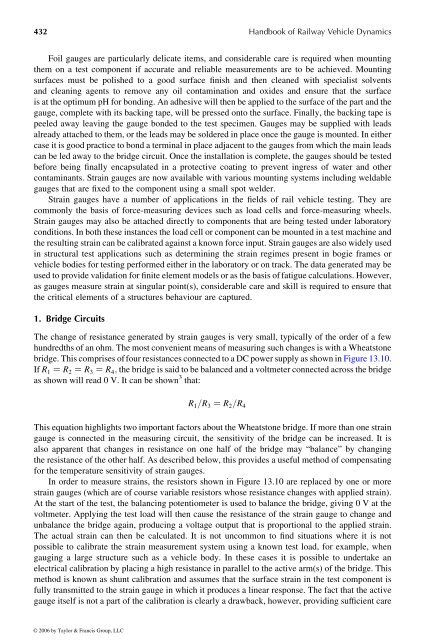You also want an ePaper? Increase the reach of your titles
YUMPU automatically turns print PDFs into web optimized ePapers that Google loves.
432<br />
Foil gauges are particularly delicate items, and considerable care is required when mounting<br />
them on atest component if accurate and reliable measurements are to be achieved. Mounting<br />
surfaces must bepolished toagood surface finish and then cleaned with specialist solvents<br />
and cleaning agents to remove any oil contamination and oxides and ensure that the surface<br />
is at the optimum pH for bonding. An adhesive will then be applied to the surface <strong>of</strong> the part and the<br />
gauge, complete with its backing tape, will be pressed onto the surface. Finally, the backing tape is<br />
peeled away leaving the gauge bonded to the test specimen. Gauges may be supplied with leads<br />
already attached to them, or the leads may be soldered in place once the gauge is mounted.Ineither<br />
case it is goodpractice to bond aterminal in place adjacent to the gauges from which the main leads<br />
can be led away to the bridge circuit. Once the installation is complete, the gauges should be tested<br />
before being finally encapsulated inaprotective coating to prevent ingress <strong>of</strong> water and other<br />
contaminants. Strain gauges are now available with various mounting systems including weldable<br />
gauges that are fixed to the component using asmall spot welder.<br />
Strain gauges have anumber <strong>of</strong> applications in the fields <strong>of</strong> rail vehicle testing. They are<br />
commonly the basis <strong>of</strong> force-measuring devices such as load cells and force-measuring wheels.<br />
Strain gauges may also be attached directly to components that are being tested under laboratory<br />
conditions. In both these instances the load cell or component can be mounted in atest machineand<br />
the resulting strain can be calibrated against aknownforce input. Strain gauges are alsowidely used<br />
in structural test applications such as determining the strain regimes present in bogie frames or<br />
vehicle bodies for testing performed either in the laboratory or on track. Thedata generated may be<br />
used to provide validation for finite element models or as the basis<strong>of</strong>fatiguecalculations. However,<br />
as gauges measure strain atsingular point(s), considerable care and skill is required to ensure that<br />
the critical elements <strong>of</strong> astructures behaviour are captured.<br />
1. Bridge Circuits<br />
The change <strong>of</strong> resistance generated by strain gauges is very small, typically <strong>of</strong>the order <strong>of</strong> afew<br />
hundredths <strong>of</strong> an ohm. The mostconvenient means <strong>of</strong> measuring such changes is with aWheatstone<br />
bridge. This comprises <strong>of</strong> four resistances connectedtoaDC powersupplyasshowninFigure 13.10.<br />
If R 1 ¼ R 2 ¼ R 3 ¼ R 4 ; the bridge is said to be balanced and avoltmeter connected across the bridge<br />
as shown will read 0V.Itcan be shown 3 that:<br />
R 1 = R 3 ¼ R 2 = R 4<br />
<strong>Handbook</strong> <strong>of</strong> <strong>Railway</strong> <strong>Vehicle</strong> <strong>Dynamics</strong><br />
This equation highlights two important factors about the Wheatstone bridge. If more than one strain<br />
gauge is connected in the measuring circuit, the sensitivity <strong>of</strong> the bridge can be increased. It is<br />
also apparent that changes inresistance onone half <strong>of</strong> the bridge may “balance” bychanging<br />
the resistance<strong>of</strong>the other half. As described below, this provides auseful method <strong>of</strong> compensating<br />
for the temperature sensitivity <strong>of</strong> strain gauges.<br />
In order to measure strains, the resistors shown in Figure 13.10 are replaced by one or more<br />
straingauges (which are <strong>of</strong> coursevariable resistors whoseresistancechangeswith applied strain).<br />
At the start <strong>of</strong> the test, the balancing potentiometer is used to balance the bridge, giving 0Vat the<br />
voltmeter. Applying the test load will then cause the resistance <strong>of</strong> the strain gauge to change and<br />
unbalance the bridge again, producing avoltage output that is proportional to the applied strain.<br />
The actual strain can then be calculated. It is not uncommon to find situations where it is not<br />
possible tocalibrate the strain measurement system using aknown test load, for example, when<br />
gauging alarge structure such as avehicle body. In these cases it is possible toundertake an<br />
electrical calibration by placing ahigh resistanceinparallel to the active arm(s) <strong>of</strong> the bridge. This<br />
method is known as shunt calibration and assumes that the surface strain in the test component is<br />
fully transmitted to the strain gauge in which it produces alinear response. The fact that the active<br />
gauge itselfisnot apart <strong>of</strong> the calibration is clearly adrawback, however, providing sufficient care<br />
© 2006 by Taylor & Francis Group, LLC









